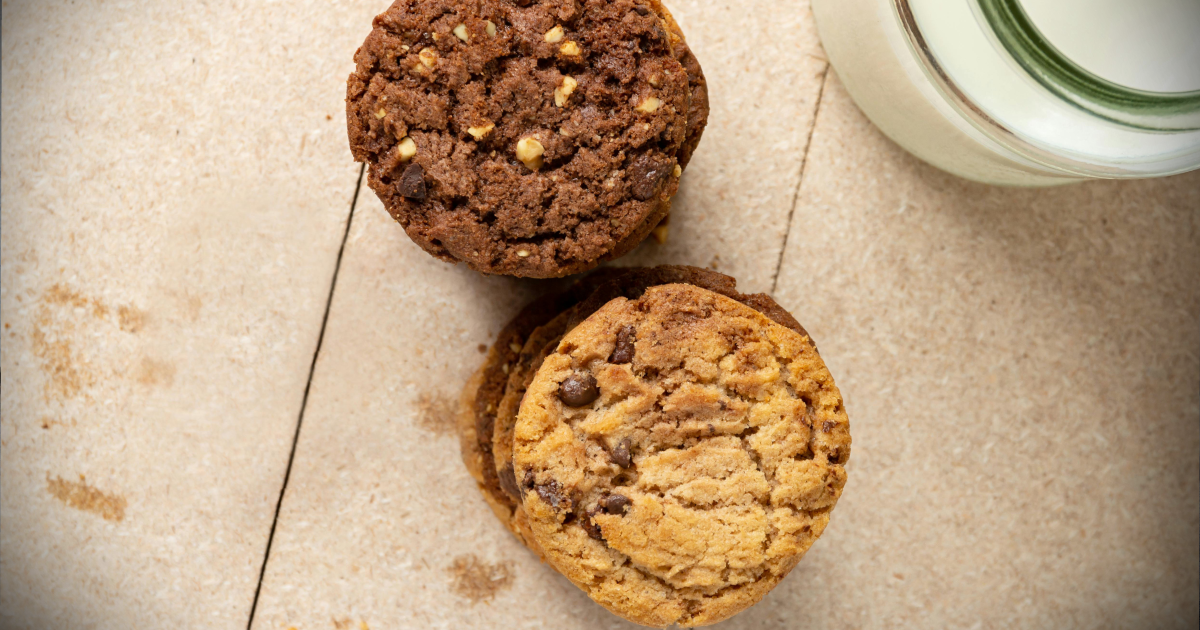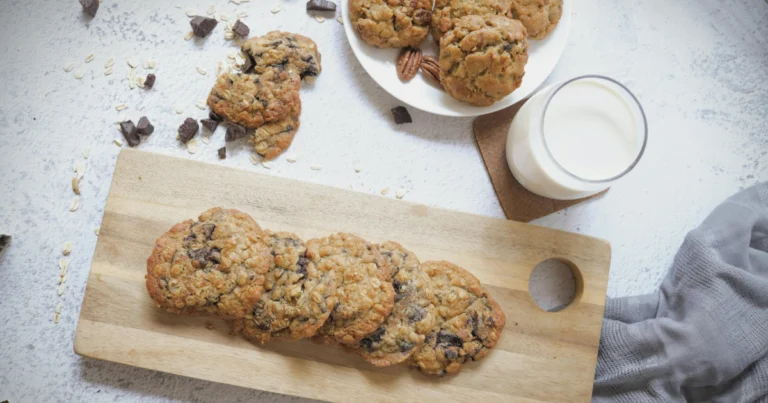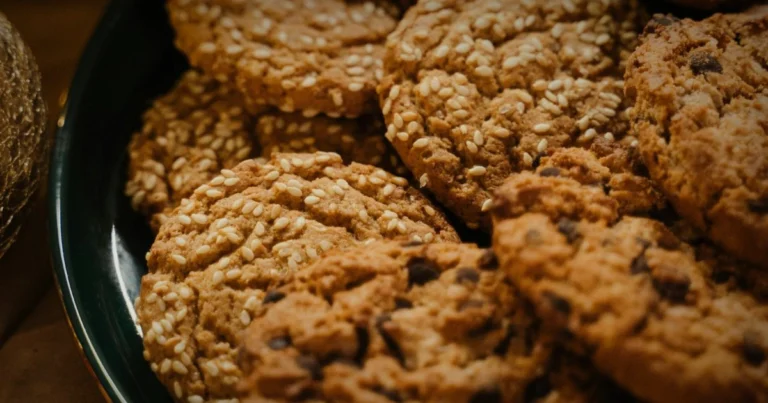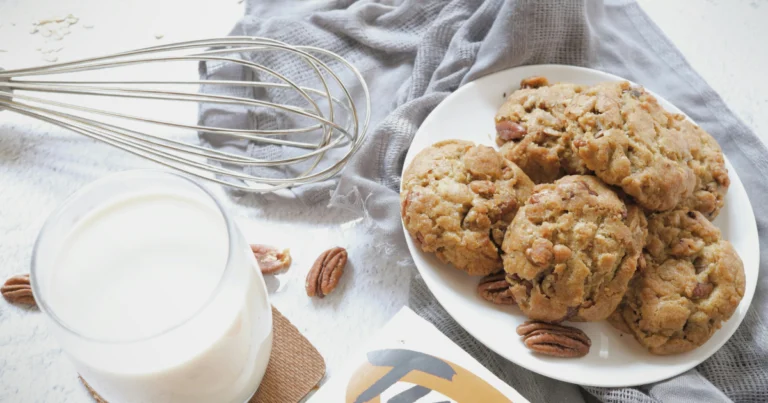What Makes Gluten and Dairy Free Cookies Taste Amazing?
Gluten and dairy free cookies are a tasty surprise for many. They have bold flavors that satisfy our cravings. You might wonder how they taste so good without wheat or milk.
Secrets lie in creative recipes. Ingredients like almond flour or coconut oil add richness. Chocolate chips, spices, or nuts boost the taste, making them just as enjoyable as traditional cookies.
Popular brands like Enjoy Life Foods show that removing allergens doesn’t mean losing flavor. They focus on quality ingredients and precise baking methods. This makes their cookies a delight for everyone, including those with dietary needs.
Table of Contents
Understanding the Allure of Gluten and Dairy Free Cookies
Gluten free cut out cookies and dairy-free options are more than just alternatives. They open up new culinary adventures. Let’s explore why these treats are so special.
What Does Gluten and Dairy Free Mean?
Gluten-free baking uses flours like almond, coconut, or rice instead of wheat. Dairy-free recipes use coconut milk or almond butter instead of milk and butter. These changes make cookies safe for those with dietary restrictions. They also bring out bold flavors.
How Dietary Restrictions Enhance Flavor
Changing ingredients can make flavors pop in surprising ways. For instance:
- Coconut oil adds a sweet tropical taste to gluten free cut out cookies.
- Almond flour brings a nutty flavor that contrasts with vanilla.
- Dark chocolate chips in dairy-free recipes offer deeper cocoa flavors.
These changes don’t just meet dietary needs. They let you discover new textures and tastes. When done right, gluten free cut out cookies celebrate creativity in the kitchen.
The Science Behind the Amazing Taste
The secret to delicious gluten free dairy free cookies lies in the kitchen. It’s where science and creativity come together. These treats use special ingredients and baking methods to taste great without gluten or dairy.
Role of Unique Ingredients
Special ingredients are key for texture and taste. Gluten free dairy free cookies often use almond flour for sweetness and protein. Coconut sugar adds a caramel taste without refined sugars.
Xanthan gum helps bind ingredients, like gluten does, but keeps the flavor the same. Brands like Bob’s Red Mill make sure their products work well together. Each ingredient is picked to avoid blandness, making the cookies complex like traditional ones.
Flavor-Enhancing Techniques That Work
Using these techniques makes ingredients shine:
- Temperature control: Baking at lower temperatures (325°F/160°C) prevents burning, letting flavors develop slowly.
- Extracts and spices: Vanilla bean paste or cinnamon amplify natural sweetness, reducing reliance on artificial additives.
- Texture balancing: Mixing in chopped nuts or dark chocolate chips (try Enjoy Life’s dairy-free options) adds crunch and depth without gluten or dairy.
These methods make every bite of your gluten free dairy free cookies special. They blend science with taste. Try changing ratios or roasting nuts before adding them to get even better results.
Ingredient Spotlight for Exceptional Flavor
Choosing the right ingredients is key to unlocking bold, satisfying flavors in gluten and dairy free cookies. Start with almond flour from brands like Bob’s Red Mill—it adds a nutty richness that balances sweetness. Swap butter for coconut oil (try Spectrum Organic) for a creamy texture that mimics dairy without the allergens.
- Natural sweeteners: Maple syrup or date paste boost depth without refined sugars.
- Spices: Cinnamon, vanilla bean, or cardamom amplify warmth and complexity.
- Texture enhancers: Chopped nuts or dark chocolate chips (70% cocoa) add crunch and intensity.
Quality counts: Freshly ground flaxseed or chia “eggs” bind better than stale options. Dark cocoa powder from Valrhona delivers deeper chocolate notes than Dutch-process varieties. Experiment with ratios—try ⅓ more almond flour than a recipe suggests to thicken batters. Prioritize ingredients with strong inherent flavors to avoid flatness. Every choice builds layers of taste that make your cookies stand out.
Baking Techniques to Achieve Perfect Texture
Getting your gluten and dairy-free cookies just right is all about the techniques. You might want them crispy or soft. Making small changes in how you mix and bake can make a big difference.
Mixing Methods and Their Effects
How you mix ingredients affects the cookie’s texture:
- Creaming method: Beat softened butter and sweeteners with a stand mixer until light. This adds air for a tender crumb.
- Hand-mixed: Mix dry and wet ingredients separately before combining. This helps avoid too much gluten, perfect for flour blends.
- No-mix approach: Just drop spoonfuls of dough onto the tray for a rustic, chunky texture.
Temperature and Baking Time Insights
Preheat your oven to 325–350°F (160–175°C) for even baking. Avoid overheating, as it can burn flours like almond or coconut. Follow these steps:
- Rotate the baking sheet halfway through baking for even browning.
- Check cookies 2–3 minutes before the recommended time. Most recipes need 12–15 minutes, but it can vary by oven.
- Let cookies rest on the tray 1–2 minutes after baking to firm up before moving them to a rack.
Exploring the Health Benefits and Nutritional Balance
Choosing gluten-free and dairy-free cookies doesn’t mean you have to give up on nutrition. These treats can give you important nutrients while meeting dietary needs. Look for ingredients like almond flour, coconut oil, or chia seeds to get more fiber, healthy fats, and protein.
Many brands, such as Enjoy Life Foods or Namaste Foods, use natural sweeteners like maple syrup or dates. This reduces the amount of refined sugar in your treats.
Gluten-free recipes often use grains like quinoa or buckwheat. These grains add minerals like magnesium and iron. Dairy-free options use plant-based milks like almond or oat milk. This adds vitamins like B12 and calcium.
These swaps help keep a nutritional balance without adding artificial additives.
Consider these benefits:
- Improved digestion: Easy-to-digest ingredients reduce bloating for sensitive stomachs.
- Weight management: High-fiber and protein content keeps you full longer.
- Allergy safety: Eliminating common allergens like wheat and milk lowers reaction risks.
Look for labels saying “no cross-contact” to ensure purity. Pair cookies with snacks like nuts or fruit for added vitamins. While enjoyable, moderation is key. Opt for brands like Schar that list short, transparent ingredient lists. Be sure to consult a healthcare professional for advice tailored to your needs.
Tips and Tricks for Customizing Your Baked Treats
Take control of your gluten-free and dairy-free cookie recipes with these easy adjustments. Every batch can become uniquely yours by tweaking ingredients and techniques to match your taste or dietary needs.
Substituting Ingredients for Personal Preferences
Swap out base ingredients without compromising texture or flavor:
| Original Ingredient | Gluten-Free/Dairy-Free Substitutes | Tip |
|---|---|---|
| All-purpose flour | Cup4Cup Gluten-Free Flour, Bob’s Red Mill 1-to-1 Baking Flour | Measure by weight for accuracy |
| Milk | Almond milk (unsweetened), oat milk, coconut milk | Add 1/2 tsp baking soda per cup of non-dairy milk |
| Butter | Clover Foods Organic Coconut Oil, Earth Balance Butter Alternative | Use solid coconut oil for richer flavor |
Enhancing Sweetness Naturally
Boost sweetness with these pantry staples:
- Use ripe bananas (½ cup mashed = ¼ cup sugar)
- Add 1-2 tbsp pure maple syrup in batter
- Incorporate dried fruit like chopped dates or apricots
Experiment with warming spices like cinnamon or nutmeg to amplify natural sweetness without added sugar.
Conclusion
Gluten-free and dairy-free cookies show that you don’t have to give up taste. Use almond flour or coconut oil and set the right baking time. This way, you get treats that are both rich and satisfying.
Try adding nuts, spices, or maple syrup to make them your own. Brands like Bob’s Red Mill have gluten-free oats for texture. Nutiva offers coconut sugar for sweetness. These options let you customize each batch.
Adding chia seeds or flax seeds boosts nutrition without losing flavor. Baking these cookies is a mix of creativity and practicality. It’s a win for both taste and health.
It’s time to start baking. Get your ingredients from trusted brands and tweak recipes to your taste. Every step brings you closer to cookies that everyone will love. Your kitchen is ready for a tasty adventure.
FAQ
What does it mean for cookies to be gluten and dairy free?
Gluten and dairy free cookies don’t have wheat flour or dairy. They’re great for people with gluten intolerance or lactose issues. This makes them safe and tasty for everyone.
Are gluten and dairy free cookies still delicious?
Yes! Bakers use special ingredients and techniques to make them tasty. Almond flour, coconut oil, and natural sweeteners make them delicious.
How can I make gluten free cut out cookies?
To make gluten free cut out cookies, use gluten free flours like almond or rice flour. Make sure your baking powder is gluten free too.
What are some good substitutes for dairy in cookies?
Try using almond milk, coconut milk, or dairy-free butter. These keep the cookies moist and flavorful without dairy.
Can I customize the sweetness of gluten and dairy free cookies?
Yes! Use maple syrup, honey, or date sugar to sweeten them naturally. You can adjust how much you use to get the sweetness you like.
Are there health benefits to choosing gluten and dairy free cookies?
Yes, they can be healthier. They often have better digestion and are more nutritious. They use healthier alternatives for better well-being.
What techniques can I use to achieve the perfect texture in gluten free cookies?
Getting the right texture is key. Mix ingredients just until combined and bake at the right temperature. This ensures they’re crispy yet chewy.
Where can I find recipes for gluten and dairy free cookies?
Look online or in gluten-free cookbooks. Websites and blogs have many recipes for different tastes. You’ll find something you like.






